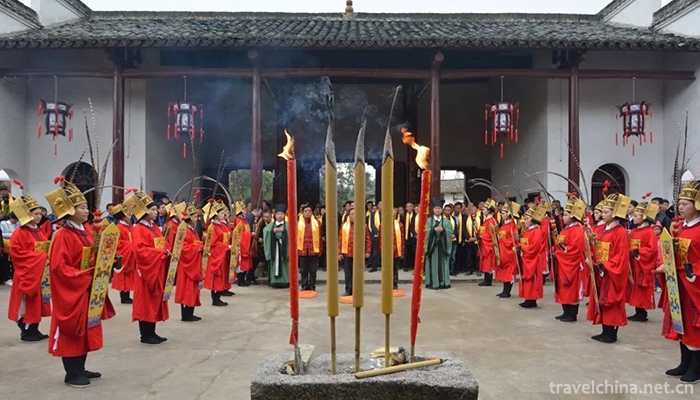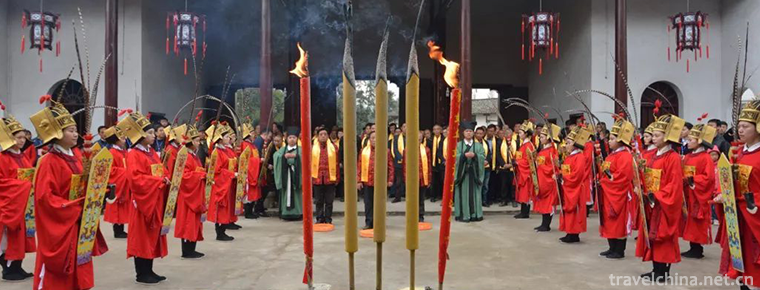Music of Confucius Festival in Liuyang Temple
Music of Confucius Festival in Liuyang Temple
The ancient music of offering sacrifices to Confucius in Liuyang Temple is a traditional folk music in Hunan Province. A list of the second batch of intangible cultural heritage in Hunan Province has been published recently. The "Liuyang Temple for Confucius and Ancient Music" declared by Liuyang City is listed in the category of "folk music".
In 2007, Liuyang City compiled and printed Liuyang intangible cultural heritage series, including Liuyang Ancient Music. According to Pan Xinzhi, the editor-in-chief, Liuyang ancient music was developed by Qiu Zhizhen, an ancient musician of Liuyang, in the ninth year of Qingdaoguang (1829 AD), in accordance with the ancient law. It included music, dance, song and ritual. The performance was very grand. Therefore, music is used in the sacrifice of Confucian temples, so it is called "Confucian ancient music sacrificed by Confucian temples". Liuyang Ancient Music was once known all over the world as "the only thing left in the whole country", especially in the late Qing Dynasty and the early Republic of China. In 1937, Professor Zhang Minjun of Hunan University wrote "The Ancient Rites of National Music in Liuyang" after Liu Guanli, which was published ten years later, reflecting the grand ceremony of sacrificing Confucius at that time.


-
1.Water surface
The water surface is a traditional snack in Shaanxi and Gansu Province. Legend has it that Liu Bang, the ancestor of the Han Dynasty
Time 2018-11-02 -
2.Mahjong
Mahjong, originated in China, is commonly known as Sparrow in Guangdong, Hong Kong and Macao. It is a game invented by the ancients of China,
Time 2018-11-13 -
3.Anhui rescue
Anhui rescue Great rescue is a traditional feature of Shouxian County in Anhui Province, which has a history of more than 1000 years.
Time 2018-11-27 -
4.Cai Lun Zhuhai
Cai Lunzhuhai is located in Huangshi Town and Dayi Town, Leiyang City, a famous historical and cultural city in central and southern China. It covers an area of 100 square kilometers and has a central
Time 2019-01-04 -
5.Dazhushan Scenic Area
Dazhushan Scenic Area is located on the southeast coast of Huangdao District. Its main peak is 486 meters with a total area of 65 square kilometers. It is mainly divided into Shimen Temple Scenic Area
Time 2019-01-08 -
6.Jingtai Yellow River Stone Forest
The Yellow River Stone Forest is located in the southeast of Jingtai County, Baiyin City, adjacent to Longwan Village, Zhongquan Township. It covers an area of about 10 square kilometers
Time 2019-01-29 -
7.Legend of windbreak
Fangfeng legend is a folk legend in Zhejiang Province. Between Fengshan and Yushan, Sanhe Township of Deqing, Huzhou, Zhejiang Province, the area of Xiazhu Lake is the largest wetland
Time 2019-04-29 -
8.Legend of Lugou Bridge
The legend of Lugou Bridge is very rich in content, including the construction of Lugou Bridge, the lion on Lugou Bridge, Lugou pier chopping dragon and sword, Lugou Xiaoyue, Lugou Bridge and Wanping
Time 2019-05-15 -
9.Baisha Xile of Naxi Nationality
Naxi Baisha Xile is also known as "Xiaoli at breaking time", "Xiaoli at breaking time", "Xili at breaking time", "Xili at breaking time" and "Xie Li at bre
Time 2019-06-06 -
10.Production Techniques of Dahongpao of Wuyi Rock Tea
Wuyi Rock Tea (Dahongpao) production technology, local traditional handicraft in Wuyishan City, Fujian Province, one of the national intangible cultural heritage.
Time 2019-06-30 -
11.The world is so big still meet you Cheng Xiang Tik Tok Songs 2020 Hot Songs
"The world is so big still meet you " is composed by htet Aung Lwin and sung by Cheng Xiang. It is the Chinese version of myanmar music "for Ma". It was officially released on Janu
Time 2020-05-21 -
12.History of Dazhou
Dazhou area belonged to Liangzhou in Xia Dynasty and Yongzhou in Yin Dynasty. The earliest indigenous people were the Cong people, who established the state of Cong (now tuxi Town, Quxian county). In the early Warring States period, Ba people migrated fro
Time 2020-12-20